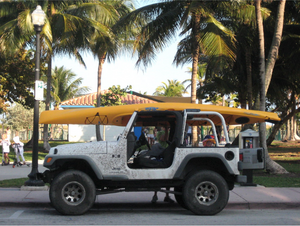Considerations when transporting your surf ski or kayak
Oct 29, 2022
5 Things To Consider When Transporting Your Surf Ski or Kayak

Photo from Flickr
There’s one thing you can be sure of when it comes to paddlers: they will always be off on another adventure. And safe transportation is crucial for every kayaker.
As with most things in life, size doesn’t matter. Transporting a kayak isn’t necessarily about having the biggest truck to put it in. It’s simply a matter of creativity, practicality, and utility.
In this article, we discuss the critical considerations when transporting your kayak or surfski.
As kayakers say:
Money can’t buy you happiness, but it can buy you a kayak, and it’s kind of the same thing.

Photo from Pexels
1. Roof Rack
If you have a big enough roof rack, you can transport your kayak or surfski even if you have a small vehicle. It serves as the bed for the kayak during transport, and it protects the kayak and the car from scratches or any form of damage.
With innovation, modern kayak racks have features that provide ease in loading and unloading the boat.
You can use a soft roof rack or a permanently fitted roof rack. A soft roof rack is removable and great for shared vehicles and short trips. They are also more affordable. For serious kayakers, permanent roof racks are better because they are significantly sturdier and better for heavier items, like a kayak and all the accessories that come with it.
When shopping for a roof rack, you must consider its specific purpose. There are certain roof racks for kayaks and surf skis that can also accommodate other items, and there are racks better suited for certain vehicles.
You can choose the type of roof rack assistance you need:
Finally, some racks allow you to load your kayak horizontally, vertically, or at an angle.
2. Crossbars
According to most kayakers, the boat is more likely to be damaged during transportation than during paddling. To ensure safety at all times, install crossbars on the roof rack to limit the possibility of dents and scratches on your kayak. You may also add crossbar pads to prevent slippage.
The crossbars must be compatible with your roof rack, so you should buy them together if you can. They must be strong and smooth because they will carry most of the weight of your kayak and other items you intend to put on the rack.
Most crossbars are made of aluminum and covered with rubber. You must check their weight capacity and ensure they are the best for your needs.
When installing the crossbars, make sure one is placed as far forward as you can and the other as far backward as possible to cover the most space.
3. Straps
Kayak straps for roof racks are just as important to keep the boat secure atop your vehicle. The straps should be strong and have a secure locking system made of rust-free material.
They should also be versatile. While the primary consideration is their ability to secure a kayak or surfski, it would also be great if the straps could secure other things like luggage, cargo, surfboard, and even a bicycle to maximize their use.
Consider the length of the straps and their lashing capacity, which is the maximum tension they can take. A lashing capacity of 600 lbs or higher is ideal for kayak straps for your roof rack.
Many kayakers prefer ratchet straps because they can be easily tied down to secure a kayak or surfski. However, they are so thick and tight that there is a risk of denting the boat.
You can try cam buckle tie-down straps, which don’t provide too much pressure that they result in distorting the kayak. And if you are not satisfied with the security these straps provide, you can add bow and stern tie-downs for your peace of mind.
To ensure the kayak is securely fastened on the roof of the car, try to push it from all directions. If it remains unmoving despite your best efforts, you should be good to go.
4. Kayak Cover
Sunlight can damage your kayak hull because of its harsh ultraviolet rays. The paint color may fade, and the material will deteriorate significantly. So, when traveling for extended periods, you must cover your kayak.
The cover can also prevent scratches and protect the kayak or surf ski from the elements during storage.
For transport, a bag-style kayak cover is best. You just slide your kayak into the bag and then secure it with a zipper. It provides protection from water possibly seeping in if it rains while you’re in transit. Find a cover that also provides UV protection when the sun is out.
5. Overhang Laws
Most territories have overhang laws, which indicate how much overhang a person can have on their vehicle. The overhang is measured from the tip of the vehicle and the tip of the object that goes beyond the end of the vehicle. These laws aim to prevent road accidents, as large overhangs can lead to collisions and other similar incidents.
In general, authorities measure the rear overhang, which means your cargo can protrude more at the front. It’s best to learn the laws and local guidelines in your own territory and wherever you are passing by or traveling to. Kayakers looking for the next big adventure must still be conscientious and prioritize safety.
For example, in Australia, each territory has its own specific rules on allowable overhangs. But the standard is a 1.2-meter overhang for most vehicles. The United States Department of Transportation has mandated that overhangs can be a maximum of four feet at the back, three feet at the front, and four inches on the sides.
Alternative Ways of Transporting a Kayak
Serious paddlers who enjoy traveling to different areas for new kayaking adventures should invest in a good roof rack, crossbars, straps, and cover. These tools are usually one-time investments unless you buy flimsy products.
However, if you don’t often travel long distances with your kayak, there are other transport methods without spending a lot of money on roof accessories.
1. Use a Pickup Truck
If you drive a sedan, consider borrowing a pickup truck or renting one for your trip. Just secure your kayak or surf ski on the truck bed. Note the overhang and make sure it doesn’t go against local regulations.
Clean the truck bed before securing the kayak because you don’t want debris damaging the boat.
2. Trailer
Attaching a trailer to your vehicle is a practical solution if you are bringing multiple kayaks at once for a group adventure or if you need to transport many other heavy sporting equipment on your trip. A trailer is also great for heavier and bigger kayaks, such as those commonly used for fishing.
But while trailers are great for transport, they can be troublesome when navigating busy streets. And it may be difficult to find parking—closely consider your route and make sure your destination can accommodate your trailer.
3. Make Your Own Roof Rack
You can also make your own roof rack if you don’t want to spend too much money on one. You can use wood or even pool noodles to secure your kayak on the roof of your vehicle.
However, the problem with DIY roof racks is that you cannot be entirely sure of their efficacy or safety. While you will save a bit of money, there is a significant risk of causing damage to your kayak or surfski.
Even if you choose an alternative way of transporting your kayak, you still need straps and other items that will secure the boat. The kayak should be covered, too, to protect it from the elements, whether it’s rain, sunlight, or small critters.

Photo from Pexels
Discover the World Through Kayaking
Kayaking or paddling is a great way to discover the world and enjoy the wonders it has to offer. The adventure itself is about being one with nature: enjoying the fresh air, appreciating the large bodies of water, and marveling at the most amazing scenery.
To discover more gorgeous natural backdrops, you can travel to different parts of the world with your kayak. Investing in the right equipment for transport is crucial to preserve the quality of your kayak or surf ski. Make sure that your boat is secure, safe, and protected during transport so you can enjoy years of adventures!

